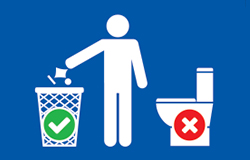Clean Water Current
NACWA, Other Associations Reach Agreement on Wipes Labeling
 NACWA’s “Toilets Are Not Trashcans” campaign reached a significant milestone with the publication of the Second Edition of Code of Practice: Communicating Appropriate Disposal Pathways for Nonwoven Wipes to Protect Wastewater Systems by INDA (Association of the Nonwoven Fabrics Industry) and its European counterpart, EDANA.
NACWA’s “Toilets Are Not Trashcans” campaign reached a significant milestone with the publication of the Second Edition of Code of Practice: Communicating Appropriate Disposal Pathways for Nonwoven Wipes to Protect Wastewater Systems by INDA (Association of the Nonwoven Fabrics Industry) and its European counterpart, EDANA.
NACWA, the Water Environment Federation (WEF), the American Public Works Association (APWA), and the Canadian Water & Wastewater Association (CWWA) worked with INDA on this updated Code of Practice (COP), which specifies how the “Do Not Flush” logo should be used on wipes that are not designed to be flushed. The major improvements made to the COP include larger sizes for the “Do Not Flush” logos and placement of the logo in a location that is “reasonably visible near the point where individual wipes are taken out of the container holding and dispensing the wipes.” In addition, the consumer must be able to see the logo without opening the package and the logo should not be obscured by packaging seals or folds.
The new COP applies to non-flushable wipes, but the definition of “flushable” has still not been agreed upon by the wastewater and wipes associations. The COP specifies that baby wipes should never be labeled “flushable,” allowing a clear “Don’t flush baby wipes” message to be delivered to consumers by both the wastewater and wipes industries.
Although the new COP is a significant improvement over the first edition, it is still voluntary. Legislation, such as the bill passed by the District of Columbia in December 2016, is still needed to make these labeling requirements mandatory. Earlier this year, Maryland proposed state legislation that was passed by the Senate but not voted on by the House. New Jersey is the latest state to propose legislation. NACWA will continue to work with states that pursue wipes legislation, and the Association is currently working on a project to develop model state legislation and supporting materials, supported by the Targeted Action Fund.